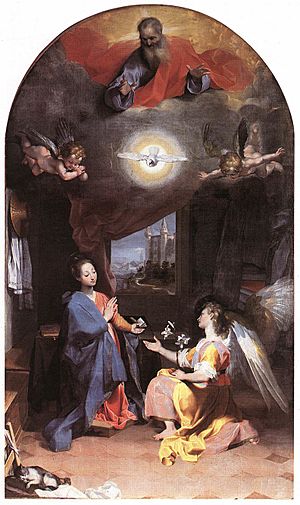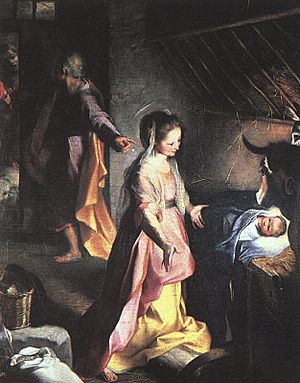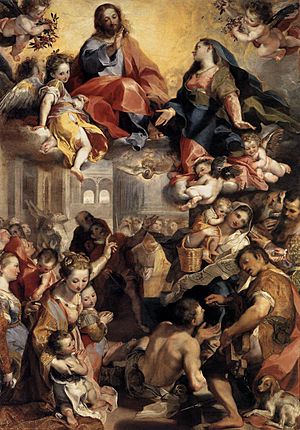Federico Barocci facts for kids
Quick facts for kids
Federico Barocci
|
|
|---|---|
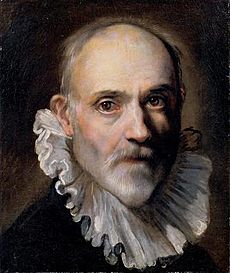
Self-portrait (c. 1600)
|
|
| Born | c. 1535 Urbino
|
| Died | Sept.30th 1612 Urbino
|
| Nationality | Italian |
| Known for | Painting |
|
Notable work
|
The Communion of the Apostles |
| Movement | Renaissance, Mannerism |
Federico Barocci (also known as Barozzi) was an Italian painter and printmaker. He was born around 1535 in Urbino, a city in Italy, and he passed away there in 1612. His real name was Federico Fiori, but people often called him Il Baroccio. His artwork was highly respected and had a big impact on other artists. His unique style even influenced later painters like Rubens. Many people consider him one of the most important and original painters in central Italy during his time.
Contents
How Did Federico Barocci Start His Art Career?
Federico Barocci was born in Urbino, which was part of the Duchy of Urbino back then. He began learning art from his father, Ambrogio Barocci, who was a well-known sculptor in the area. Later, he became a student of the painter Battista Franco in Urbino.
In 1548, Federico traveled to Rome with his uncle, Bartolomeo Genga. In Rome, he worked in one of the best art studios of that time, run by the Mannerist painters Taddeo and Federico Zuccari. This experience helped him learn a lot about art.
What Was Barocci's Main Work Like?
After spending four years in Rome, Barocci went back to his hometown of Urbino. His first major painting there was St. Margaret. Later, Pope Pius IV invited him back to Rome to help decorate the Vatican Belvedere Palace. There, he painted a beautiful scene of the Virgin Mary and infant, with several Saints and a ceiling fresco showing the Annunciation.
During this second visit to Rome, Barocci became very sick. He thought someone might have poisoned his food. Fearing he would die, he left Rome in 1563. Even though he often felt unwell, he kept painting for almost 40 more years! His paintings are full of life and bright colors, even though he was described as a bit gloomy himself.
Barocci never returned to Rome. He mostly worked for Francesco Maria II della Rovere, the Duke of Urbino, in his hometown. You can sometimes see the Ducal Palace in the background of his paintings, drawn in a way that makes it look far away.
How Did Barocci Create His Art?
Even though Barocci stayed away from Rome, which was the center of the art world, he kept trying new things with his style. He might have seen drawings made with colored chalk by Correggio. However, Barocci's own pastel drawings are some of the earliest examples of this technique that still exist today.
Barocci was also one of the first artists to use oil sketches. In his pastel and oil sketches, his soft and glowing colors create a dreamy, almost magical feeling. He used a very detailed process to create his large altarpieces. He would make many sketches for each painting, including:
- Quick drawings to plan the overall look.
- Studies of people's poses using models.
- Studies of how light would fall on the scene, sometimes using clay models.
- Drawings to figure out the perspective.
- Studies of colors and natural details.
Today, we have over 2,000 of his drawings! Every small detail of his final paintings was carefully planned this way.
A great example is his famous Madonna del Popolo (Uffizi). This painting is full of color and energy, thanks to the many different people, poses, and natural details. There are many surviving drawings for this painting, from early ideas to color studies of faces, all the way to the final full-size drawing. Even with all this careful planning, Barocci's paintings still look lively and full of emotion. A special, glowing light seems to shine on faces, hands, clothes, and the sky in his works.
Barocci was also very involved with the Counter-Reformation, a movement within the Catholic Church. Around 1566, he joined a group called the Capuchins. He may have been inspired by Saint Philip Neri, who wanted to connect spiritual ideas with everyday life. Saint Philip Neri asked Barocci to paint two large altarpieces for his church: The Visitation (1583-86) and Presentation of the Virgin (1593–94). People say Neri was deeply moved by Barocci's Visitation, which shows the Virgin Mary and Elizabeth greeting each other.
In Urbino, Barocci painted a Descent from the Cross for the cathedral in Perugia. He visited Rome again when Pope Gregory XIII was in charge. During this visit, he painted two amazing pictures for the Chiesa Nuova: The Visitation of the Virgin Mary to Elisabeth and The Presentation in the Temple. He also painted a Last Supper for the Chiesa della Minerva.
Why Is Barocci Important in Art History?
Art historian Giovanni Bellori, who wrote about artists during the Baroque period, thought Barocci was one of the best painters of his time. Barocci's emotional style of painting greatly influenced Peter Paul Rubens when Rubens was in Italy. Rubens even made a sketch of Barocci's dramatic Martyrdom of St Vitale. Rubens' own painting, The Martyrdom of St Livinus, seems to have been inspired by Barocci's work.
Many artists worked with or were influenced by Barocci, including Antonio Cimatori, Ventura Mazza, Antonio Viviani, and Alessandro Vitali. His unique way of arranging figures in a swirling motion and focusing on deep emotions and spiritual feelings helped pave the way for the Baroque art style that came after him, especially seen in the works of Rubens and Bernini.
Famous Artworks by Federico Barocci
| Painting | Date | Location | Image link | |
|---|---|---|---|---|
| Martyrdom of St Sebastian | 1557 | Urbino Cathedral | ||
| Madonna di San Simone | 1567 | Galleria Nazionale delle Marche, Urbino | ||
| Deposition | 1567-69 | Perugia Cathedral | ||
| Rest on the Flight to Egypt | 1570 | Pinacoteca Vaticana, Vatican | 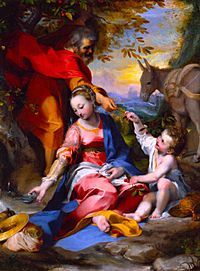 |
|
| Nativity | 1597 | Museo del Prado, Madrid | 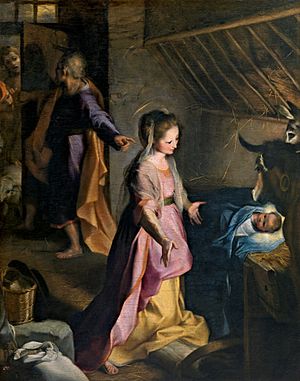 |
|
| The Vision of St Francis | San Francesco, Urbino | |||
| Madonna del Popolo | 1575-79 | Uffizi, Florence | 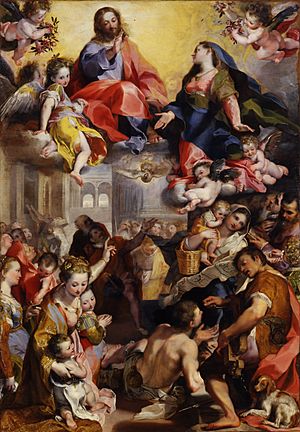 |
|
| Entombment | 1580-2 | Chiesa della Croce, Senigallia | ||
| Martyrdom of San Vitale | 1583 | Pinacoteca di Brera, Milan | ||
| Portrait of a Young Man | ca. 1580–85 | Musée des Beaux-Arts de Strasbourg | 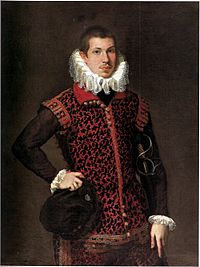 |
|
| Circumcision | Paris | 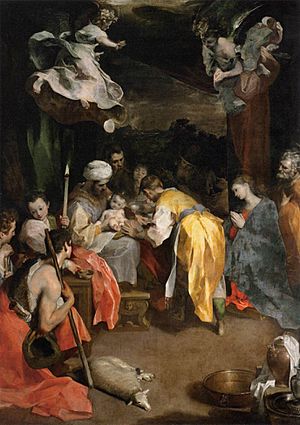 |
||
| Annuciation | 1592-96 | Basilica of Santa Maria degli Angeli, Assisi, Perugia | ||
| Aeneas' Flight from Troy | 1598 | Galleria Borghese, Rome | 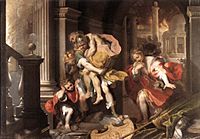 |
|
| St Jerome | 1598 | Galleria Borghese, Rome | ||
| Portrait of Francisco II della Rovere | 1572 | Uffizi, Florence | ||
| Christ and Mary Magdalen (Noli me tangere) | 1590 | Gemaldegalerie, Munich | ||
| Entombment (etching) | 1579–1582 | Getty Museum, Los Angeles | ||
| Quintilia Fischeri | c. 1600 | National Gallery of Art, Washington, D.C. | ||
| Annunciation (etching) | ||||
| St Francis receives the stigmata (drawing) | Accademia Carrara, Bergamo | |||
| Madonna with Sts Simon and Jude | Galleria Nazionale delle Marche, Urbino | |||
| Vocation of Saints Peter and Andrew | 1586 | Royal Museums of Fine Arts of Belgium | ||
| Madonna and Child with the Infant John the Baptist and St Joseph (Madonna with the Cat) | c. 1575 | National Gallery, London | ||
| Communion of the Apostles | c. 1603~1608 | Santa Maria sopra Minerva, Rome | 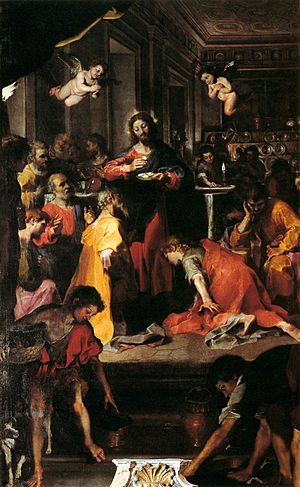 |
Images for kids
See also
 In Spanish: Federico Barocci para niños
In Spanish: Federico Barocci para niños


